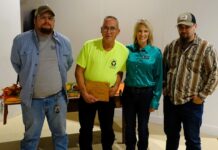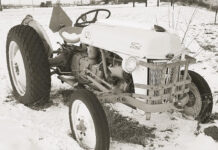Fairbanks-Morse Power and Concrete Pumping — wow, that name says a lot about Coolspring Power Museum’s little machine (pictured to the right)! But what is it and what does it do? Good questions. So let’s look around a bit and see what we can find — hmmm.
We have a cute, little Fairbanks-Morse engine belted to a Fairbanks-Morse pumpjack running an apparent hopper and pumping apparatus. I’m not sure if it is factory- or shop-made. There is no identification — fascinating! So let’s take a journey to really look at it. I think you will enjoy.
So why pump concrete? Well, it transfers concrete to areas of the job that cannot be reached by the big mixer truck. Our little rig has a 2-inch discharge hose, while huge trucks have long and wide delivery pipes — all to make the job easier.
So what is concrete? It’s the second most common building material in the world. It’s made from cement, water and aggregate stones. Better yet, cement is made from limestone and clay. How fortunate that all of these materials are fairly common in nature and essentially nontoxic. Just look around and you’ll see concrete almost everywhere.
Engine

So now, I want to turn the reader’s attention to our machine’s engine. Commonly known as the “salt block” due to its shape, it is a Fairbanks-Morse model Z style D 1 1/2 HP engine. Appearing in 1928, with a 2 1/4-inch bore and 3 1/4-inch stroke, it ran at 1,500 RPM. The valves are located in the block, ushering in a new phase of engine design. It had a single wheel on one side and a pulley on the other running at half speed. This made it very versatile for multiple uses. The engine’s design was really quite simple, accounting for the large market it served. Note the auxiliary cooling water tank, which our engine has. I presume this was an aftermarket addition.

Pumpjack
Moving on, we will now look at the pumpjack driven by the engine. Fairbanks Morse actually made a myriad of pumpjacks for every possible use.
As shown, our unit is fairly heavy-duty for the small engine. There was one reciprocating lever that could activate an overhead beam or could pump a well. Note how the jack is formed to nestle around the well casing.
Finally, the entire unit is mounted on an attractive four-wheel cart — a useful and attractive display.













